Whether you’re new to the sport or an experienced cyclist, knowing the parts of a road bike and what they’re for can help you become a better cyclist. Understanding the anatomy of your bike can help you identify issues or opportunities to improve your ride. In this guide, we’ll take you part by part through road bike anatomy, explaining the purpose and function of each component so you’ll never be confused at the bike shop again.
What are the five main parts of a road bike?
The following five key elements of a road bike are the essential building blocks that make up a road bike's functionality. In the following section, we will delve deeper into each of these components and explore their purpose.
1. Frame
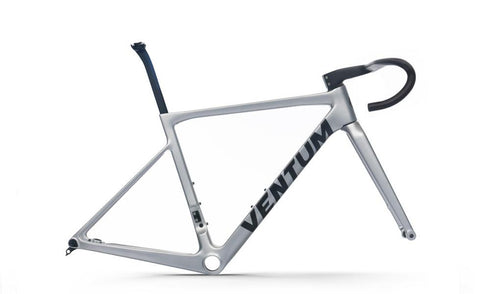
The frame serves as the structural backbone of the bicycle. It connects and supports all other components. Frames can be made from various materials such as steel, aluminum, carbon fiber, or titanium and come in different shapes and sizes to accommodate different types of bicycles. Road bike frames are usually made from materials like aluminum, carbon fiber, or steel.
Learn how to measure bike size in our Road Bike Sizing Guide →
2. Wheels and tires
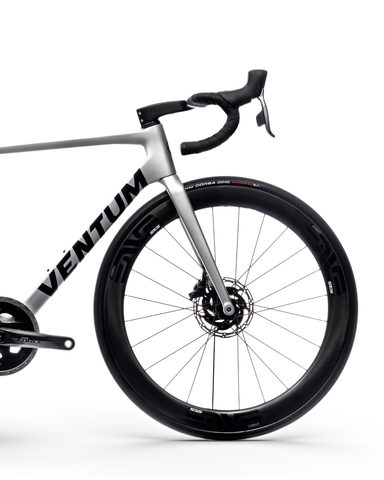
You can’t go anywhere without these! Bicycle wheels are essential for movement and balance. They consist of the hub (center of the wheel), spokes, rim, and tire. The size and type of wheels can vary depending on the bicycle's purpose. For instance, road bikes typically have larger, thinner wheels, while mountain bikes have sturdier, smaller wheels with knobby tires for better traction on rough terrain.
3. Drivetrain

The drivetrain refers to the collection of components and parts that work together to transfer power from the rider's pedaling motion to the bike's wheels, propelling it forward. Parts that make up the drive train are the derailleurs, chain, crankset, cassette, and bottom brackets.
The choice of specific drivetrain components, such as the number of gears, gear ratios, and the type of drivetrain (e.g., single-speed, multi-speed), can vary depending on the type of bicycle and its intended use. Proper maintenance and tuning of the drivetrain are essential for smooth and efficient cycling.
4. Steering
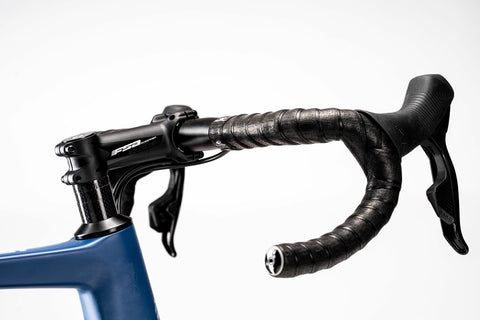
The steering system of a road bike primarily consists of the components that enable the rider to control the bike's direction and stability. The stem, headset, fork, bearings, and bar ends are the main components of a road bike steering system. The combination of drop handlebars, stem adjustments, and the headset's bearing quality allows riders to fine-tune their riding position for optimal handling and performance. Road bikes are typically built for speed and agility, and the steering system plays a crucial role in achieving these characteristics.
5. Finishing kit
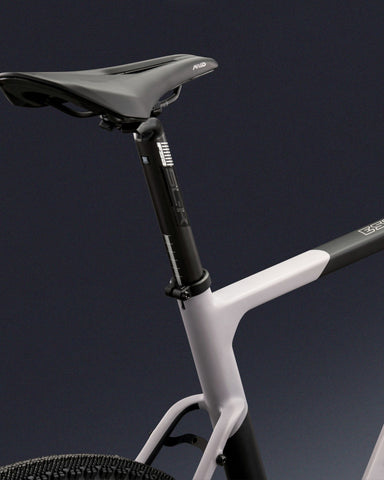
The finishing kit on a road bike consists of a collection of components and accessories that contribute to the final appearance, functionality, and comfort of the bike. The finishing kit includes various parts that complete the build of the road bike and allow it to be ready for riding, such as the pedals, handlebars, and saddle.
Learn what you need to know when shopping for a road bike
Complete list of bike parts and components
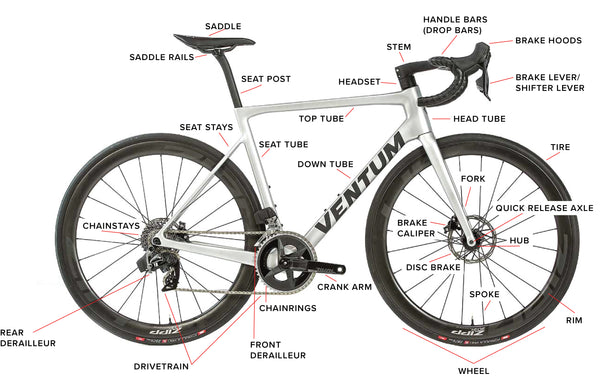
Bikes are made up of many smaller parts and components that help you generate speed, maintain balance, or apply brakes. Here are all the parts that make up a bike.
Parts of a road bike frame
Top tube
The top tube is the horizontal tube that runs from the head tube (at the front of the frame) to the seat tube. It helps define the frame's overall geometry and provides lateral stiffness.
Down tube
The down tube is another horizontal tube that runs from the head tube to the bottom bracket shell. It's one of the main load-bearing members of the frame and contributes to the frame's strength and rigidity.
Seat tube
The seat tube connects the top tube and down tube to the seat stays and seat post. It houses the seat post and saddle, and its length and angle determine your seating position.
Head tube
The head tube is located at the front of the frame and holds the fork's steerer tube. It also houses the headset, which allows the front wheel to turn and the handlebars to control steering.
Seat stays
Seat stays are two slender tubes that run from the seat tube to the rear dropouts (where the wheel axles are attached). They help absorb shock and impact from the rear wheel and contribute to the frame's overall compliance and comfort.
Chain stays
Chain stays connect the bottom bracket shell to the rear dropouts and provide support for the rear wheel and drivetrain components. They play a significant role in power transfer and frame stiffness.
Bottom bracket
The bottom bracket is a component that houses the bearings that allow the crankset to rotate. It is mounted inside the frame and is connected to the crankset via the bottom bracket spindle.
Bottom bracket shell
The bottom bracket shell is the part of the frame where the bottom bracket, which holds the crankset and pedals, is installed. It's a critical component for power transfer and pedal efficiency.
Dropout
Dropouts are located at the rear of the frame and front fork. They provide attachment points for the wheel axles so they can be secured to the frame. Some dropouts also feature provisions for mounting disc brake calipers.
Parts of road bike wheels
Rim
The rim is the outer circular component of the wheel, which holds the tire in place. It is typically made of materials like aluminum or carbon fiber and is available in various depths and widths to suit different riding styles and conditions.
Spokes
Spokes are thin, metal rods that connect the rim to the hub, forming a network of support for the wheel. The spokes maintain the wheel's structure and tension, distributing the load from the hub to the rim.
Hub
The hub is the central part of the wheel, located at the wheel's core. It houses the wheel's bearings and the axle, enabling the wheel to rotate. Hubs are equipped with flanges for spoke attachment and come in different designs, including front and rear hubs, as well as those designed for different types of axles (quick-release or thru-axle).
Axle
The axle is a central shaft that runs through the hub, providing support for the wheel. The axle attaches to the bike's frame or fork, allowing the wheel to spin freely. The design and diameter of the axle may vary depending on the type of bicycle and its intended use.
Quick release or thru-axle (front and rear)
These are the mechanisms used to secure the wheel to the frame or fork. Quick releases are commonly used on road bikes and some mountain bikes, while thru-axles provide increased stiffness and security, particularly on mountain bikes.
Nipples
Nipples are small, threaded components that connect the spokes to the rim. By adjusting the tension of the nipples, the wheel's trueness and roundness can be fine-tuned.
Rim tape
Rim tape is a strip that covers the spoke holes inside the rim to prevent the inner tube from being punctured by the sharp edges of the spoke holes.
Tire
The tire is the outermost part of the wheel and makes contact with the road or trail surface. It is available in various sizes and tread patterns to suit different riding conditions and terrain.
New to cycling? Learn how to change a bike tire so you never get stranded on a ride.
Tube
Some bikes use inner tubes that sit inside the tire and hold the air pressure. Tubeless tire setups, which omit inner tubes, are more popular for road cycling. If you prioritize speed, efficiency, and puncture resistance, tubeless tires may be the better choice. However, if simplicity and cost-effectiveness are your main concerns, traditional tube tires can still provide a reliable option.
Valve
The valve is a small, usually threaded component on the inner tube that allows for inflation and deflation of the tire. Common valve types include Presta and Schrader valves.
Parts of the drivetrain
Chain
The chain is a critical component of the drivetrain that transfers power from the pedals to the rear wheel, propelling the bike forward. Chains are made of metal links and come in various widths and speeds.
Chainrings
Chainrings are the toothed wheels located on the crankset. They are connected to the pedals and affect the gearing of the bicycle. Bicycles can have one, two, or three chainrings on the crankset, depending on the drivetrain setup.
Cassette
The cassette, found on the rear wheel, consists of multiple sprockets with teeth of varying sizes. It works in conjunction with the chain and rear derailleur to control the bike's gearing.
Front Derailleur
In a multi-speed bicycle, the front derailleur is responsible for shifting the chain between the chainrings to change gears.
Rear Derailleur
The rear derailleur is a component that shifts the chain between the sprockets on the rear cassette to change gears.
Crankset
A crankset, often simply referred to as the "cranks," is a major component of a bicycle's drivetrain that plays a central role in powering the bike. It consists of two or three chainrings and one or two crank arms. The crank arms are connected to the pedals. When you pedal, you apply force to the crank arms, which, in turn, rotate the chainrings.
Crank Arms
Crank arms are the two elongated components that connect the pedals to the bicycle's crankset. They play a key role in translating your pedaling motion into forward propulsion. Crank arms are typically made of lightweight and strong materials like aluminum, carbon fiber, or occasionally steel, depending on the type of bike and its intended use.
Road bike steering components
Stem
The stem connects the handlebars to the fork's steerer tube, allowing for steering control and positioning of the handlebars. It comes in various lengths and angles to adjust your reach and height.
Headset
The headset is the bearing assembly that sits in the head tube of the bike frame. It enables the handlebars to turn smoothly and control the direction of the front wheel. Headsets can be integrated, external, or internal, depending on the frame design.
Fork
The bike fork is a crucial component of a bicycle's front end, and it plays a significant role in supporting the front wheel, controlling steering, and absorbing shocks and vibrations. It is located at the front of the bicycle frame and connects to the frame's head tube via the headset.
Bearings
Bearings are located inside the hub and allow the wheel to rotate smoothly around the axle. They reduce friction, providing efficient motion. Bearings can be sealed or unsealed, with sealed bearings being more common in modern bicycle wheels.
Bar ends
Bar ends are extensions that can be added to the ends of flat or riser handlebars. They provide additional hand positions for comfort and leverage, particularly during climbs.
Parts of a road bike finishing kit
Pedals
Pedals are, of course, how you power the bike. They can be flat pedals, platform pedals, clipless pedals (used with cycling-specific shoes), or toe clip pedals, depending on the type of riding and rider preference.
Handlebars
The handlebars, stem, and associated components allow you to control the bicycle's direction and make steering adjustments. Handlebar types can vary and include flat bars, riser bars, drop bars, and more, each suited to different riding styles. Drop bars are the most common handlebar type for road bikes.
Shifters
Shifters are found on the handlebars and are used to change gears. They control the front and rear derailleurs, allowing you to switch between different gears for various terrain and riding conditions.
Saddle
The bike seat, usually referred to as the saddle, is a critical component of the bicycle that directly affects your comfort and overall cycling experience. Bike seats come in various shapes, sizes, and materials to accommodate different riding styles and preferences.
A bike saddle consists of a shell, a cover, and often padding. The shell is the rigid, often plastic or carbon fiber base of the saddle that provides its shape and structure. The cover is the outermost layer of the saddle, providing a smooth, durable, and comfortable surface for you to sit on. It is typically made from materials like synthetic leather or microfiber. Many saddles also feature padding to enhance rider comfort.
The two parallel bars underneath the saddle are called the rails–these connect it to the seat post. The rail clamp is the part of the saddle that attaches to the seat post. It may have adjustable features that allow you to set the saddle's angle and position to optimize comfort and pedaling efficiency.
Discover 10 of the Best Road Bike Saddles →
Parts of a road bike braking system
Brakes
Brakes are essential for slowing down and stopping the bicycle. There are various types of brakes, including rim brakes (e.g., caliper brakes, cantilever brakes) and disc brakes (mechanical or hydraulic).
Brake calipers
Brake calipers are the components that apply pressure to the brake pads, squeezing them against the rim or rotor to generate braking force.
Brake rotors
Brake rotors are the circular discs used with disc brakes. When the brake pads make contact with the rotor, it generates friction and slows the bike down.
Brake pads
Brake pads are the replaceable components that make contact with the rims or rotors when braking. They wear down over time and need periodic replacement.
Brake levers
Brake levers are mounted on the handlebars and are used to operate the brakes. They transmit your input to the brake calipers, allowing for controlled stopping.
Understanding bike anatomy enhances your enjoyment of cycling, safety, and independence. Whether you're a casual rider or a serious cyclist, this knowledge can make you more confident when in the saddle or discussing parts of your road bike at your local bike shop.
Though not technically part of the bike anatomy, you can’t go riding without the right cycling apparel! Check out the Hincapie apparel collection and reach out with any questions – we’re always happy to help.
You might also like:
